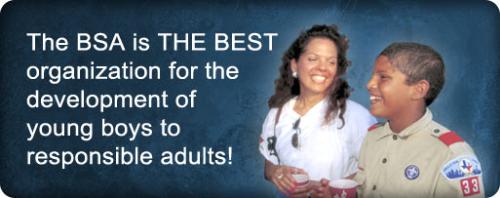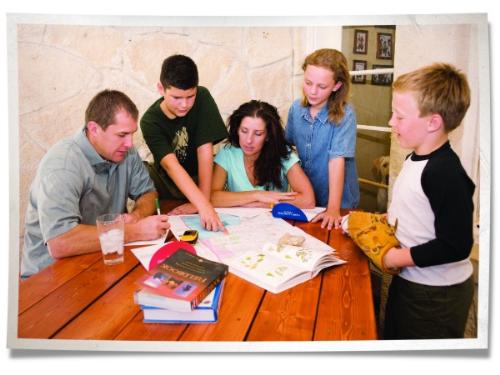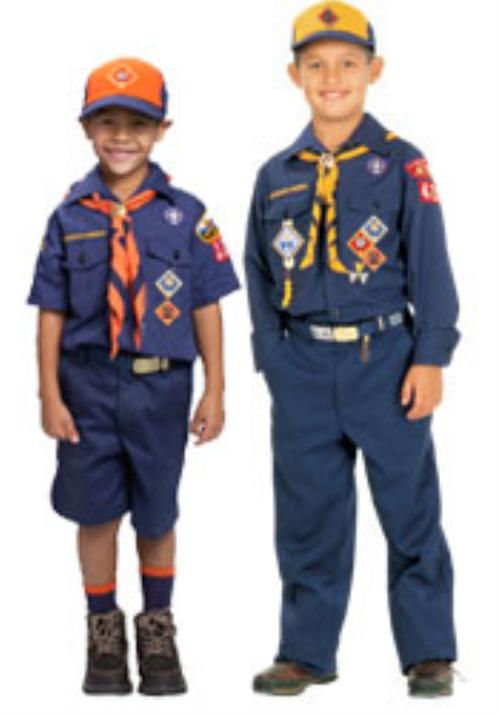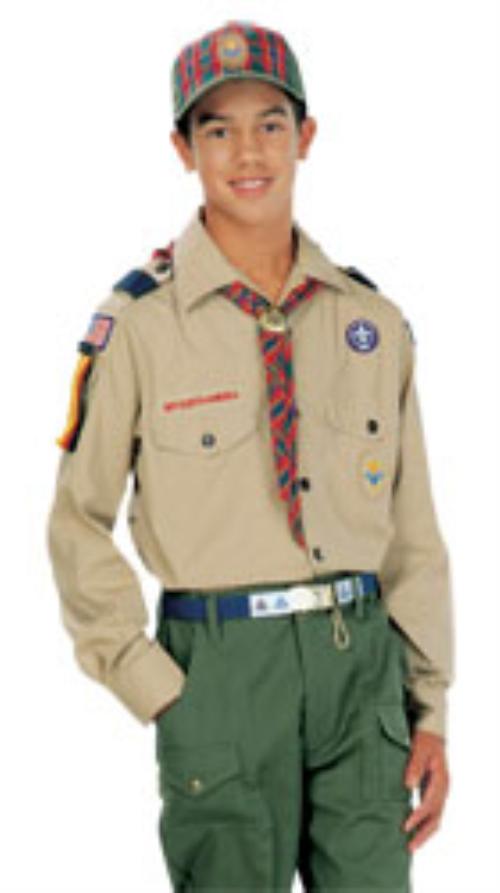|
|
|
|
|
|
|
|
|
|
|
|
|
 |
 |
 |
 |
|
 |
 |
 |
 |
|
|

Providing a Compass for Life For almost 100 years, Scouting programs have instilled in youth the values found in the Scout Oath and Scout Law. Today, these values are just as relevant in helping youth grow to their full potential as they were in 1910. Scouting helps youth develop academic skills, self-confidence, ethics, leadership skills, and citizenship skills that influence their adult lives. The Boy Scouts of America provides youth with programs and activities that allow them to - Try new things.
- Provide service to others.
- Build self-confidence.
- Reinforce ethical standards.
While various activities and youth groups teach basic skills and promote teamwork, Scouting goes beyond that and encourages youth to achieve a deeper appreciation for service to others in their community. Scouting provides youth with a sense that they are important as individuals. It is communicated to them that those in the Scouting family care about what happens to them, regardless of whether a game is won or lost. Finally, and perhaps most importantly, Scouting promotes activities that lead to personal responsibility and high self-esteem. As a result, when hard decisions have to be made, peer pressure can be resisted and the right choices can be made.
For more information, please click on the "Contact our Pack" link and email us!
|
|
 |
 |
|
Icon
|
File Name
|
Comment
|
|
 |
PARENT INFO#520-259.pdf |
Parent information Guide |
|
|
 |
 |
 |
 |
 |
 |
 |
 |
|
 |
 |
 |
 |
|
|
Frequently Asked Questions
Joining Cub Scouting
Cub Scouting is for boys in the first through fifth grades, or 7 to 10 years of age. Boys who are older than 10, or who have completed the fifth grade, can no longer join Cub Scouting, but they may be eligible to join the Boy Scouting or Venturing program
Express your interest to the pack leaders—the Cubmaster, chartered organization representative, or members of the unit committee. While there's no guarantee that a specific role or position will be available—and there may be a selection process among several candidates even if the position is currently vacant—there is usually some way in which you can contribute, and most units are glad for any offer of help.
In most instances, yes: there are tens of thousands of Cub Scout packs in the United States and its territories, as well as packs that serve the families of U.S. citizens who live overseas. The "find a pack" feature at www.joincubscouting.org will show you a sample of the units in your area.
In rare instances where there actually is no pack in your area—which generally occurs only in rural areas or overseas locations—a single youth can become a Lone Cub Scout, working with an adult mentor to pursue the advancement program, and participating in activities with nearby packs when possible.
Citizenship is not required of youth or adult members.
If you live outside the United States and are not a U.S. citizen, it may be more beneficial to join the Scouting association in your own nation. The World Organization of the Scout Movement provides contact information for all national Scouting organizations on its Web site at www.scout.org .
|
|
 |
 |
|
 |
 |
 |
 |
 |
 |
 |
 |
|
 |
 |
|
|
The Cub Scout Program
Cub Scouting is a program of the Boy Scouts of America—so in that sense, Cub Scouts and Boy Scouts are both members of the same organization. However, they are entirely different programs: Cub Scouting is a family-oriented program designed specifically to address the needs of younger boys.
Cub Scouts meet in their dens once each week, and a pack meeting is held for all Cub Scouts and their families once a month. Beyond that, it depends on the den and pack: a den may hold a special activity, such as a service project or visit to a local museum in place of one of the weekly meetings or in addition to the weekly meetings. Likewise, a pack may conduct a special event such as a blue and gold banquet as an additional event, rather than a substitute for its monthly pack meeting. Pack 61 meets every Friday 7-8pm at Brookside School. We have one pack meeting, one family night and two den meeting each month. need more info contact us
Cub Scout den meetings are intended to be an activity for the individual boys. They are not a family activity, and the presence of parents can be a distraction. However, parental involvement is not forbidden and all meetings should be open to your participation. If you would like to be present at a den meeting, ask the den leader in advance so that the leader can plan a way for you to observe or participate in an unobtrusive manner. Parents arealways needed to put together activities, field trips, Blue and Gold Dinner just to name a few things.Tigers must be accompied by thier parent or adult.
|
|
 |
 |
|
 |
 |
 |
 |
 |
 |
 |
 |
|
 |
 |
|
|
A Family Program

Family involvement is essential to Cub Scouting's success. When we talk about "family" in Cub Scouting, we're sensitive to the realities of present-day families. Many Cub Scouts do not come from traditional two-parent homes. Some boys live with a single parent or with other relatives or guardians. Cub Scouting considers a boy's family to be the people with whom he lives.
Family Activities
As a program for the entire family, Cub Scouting can help families teach their children a wholesome system of values and beliefs while building and strengthening relationships among family members.
Your Role as a Parent
Cub Scouting helps parents and sons grow closer, and your involvement as a parent of a Cub Scout is vital.
Becoming a Leader
Volunteer leaders support Cub Scouting by serving in many roles, and often find great satisfaction in lending their support to youth and the community.
The BSA Family Award
The BSA Family Award program offers activities to help strengthen all families—whether two-parent, single-parent, or nontraditional.
Family involvement is essential to Cub Scouting's success. When we talk about "family" in Cub Scouting, we're sensitive to the realities of present-day families. Many Cub Scouts do not come from traditional two-parent homes. Some boys live with a single parent or with other relatives or guardians. Cub Scouting considers a boy's family to be the people with whom he lives.
Family Activities
As a program for the entire family, Cub Scouting can help families teach their children a wholesome system of values and beliefs while building and strengthening relationships among family members.
Your Role as a Parent
Cub Scouting helps parents and sons grow closer, and your involvement as a parent of a Cub Scout is vital.
Becoming a Leader
Volunteer leaders support Cub Scouting by serving in many roles, and often find great satisfaction in lending their support to youth and the community.
The BSA Family Award
The BSA Family Award program offers activities to help strengthen all families—whether two-parent, single-parent, or nontraditional.
|
|
 |
 |
|
 |
 |
 |
 |
 |
 |
 |
 |
|
 |
 |
|
|
Advancement and Awards
No. In the Cub Scout program, all boys in a den work toward the same badge. If a boy joins Cub Scouting as a 9-year-old, he must earn the Bobcat badge (all boys in Cub Scouting earn this badge), and then he will begin working on the Bear badge with his fellow Cub Scouts. He is not required to have earned the Tiger Cub or Wolf badges. Since those badges are for younger boys (7- and 8-year-olds), the requirements for those badges are below a 9-year-old's current level of ability, so "going back" to pick up those badges is not permitted.
No. In the Cub Scout program, all boys in a den work toward a badge that is geared to their level of development. If the Wolf badge is completed before the end of the program year, a boy may work on electives to earn Arrow Points, but he may not begin working on the requirements for the Bear badge. His work on the Bear badge will begin the next program year, when he graduates into a Bear den.
Cub Scouts are not eligible to earn these awards, which are part of the Boy Scout program. All of the awards that Cub Scouts may earn are listed in their handbooks or listed on BS Web site.
Boy Scouting is available to boys who have earned the Arrow of Light and are at least ten years old—so a Webelos Scout who has earned the Arrow of Light is eligible to join a troop immediately (provided he is at least ten years old).
However, many packs coordinate with a local Boy Scout troop to facilitate the transition from Cub Scouting to Boy Scouting. In these instances, it is better for the boy, his family, and both units if all Webelos Scouts make the transition together, in a coordinated fashion, rather than having each boy leave the pack as soon as he is eligible.
|
|
 |
 |
|
 |
 |
 |
 |
 |
 |
 |
 |
|
 |
 |
|
|
Uniform and Supplies
At minimum, each boy in Cub Scouting will need a uniform and a handbook. Each year, the handbook changes, as does the cap and neckerchief, but other uniform parts remain the same for at least the first three years. When a boy enters a Webelos den, he may need to obtain a new uniform if the parents in the den opt for the khaki-and-olive uniform.
Additional supplies and equipment may be needed for certain activities such as camping trips or field days. What equipment is needed, as well as whether it will be provided by the unit, will vary from pack to pack. Den and pack leaders should provide parents with information about any supplies that will be required at the beginning of each program year.
Our uniforms, literature, and other Scouting merchandise is available at your local council, Scout Shops, and other licensed distributors. Visit the Supply Division Web site at www.scoutstuff.org to find a list of distributors in your area. If there aren't any suppliers near you, you can order directly from the Supply Division by telephone.
The Cub Scout pack may provide assistance to families. Some packs operate a uniform exchange or uniform bank, or they may hold fund-raisers to enable the boys to earn their uniforms. Also, some packs will award boys rank-specific uniform components (hat and necherchief) and/or the program books that the Cub Scout needs each year—so parents should inquire as to what the pack provides before purchasing the items themselves.
|
|
 |
 |
|
 |
 |
 |
 |
 |
 |
 |
 |
|
 |
 |
|
|
The Cub Scout Uniform
Wearing uniforms has been a method of the Scouting movement from the beginning. Decades of experience show uniforming to have many benefits, including these:
- Equality. The uniform represents a democratic ideal of equality. Boys from various cultures and different economic levels wear the same uniform and cooperate as equals.
- Identification. The uniform identifies a boy as a member of the Cub Scouts. Badges on the uniform tell other members that he belongs to their den, pack, and council. The uniform itself identifies a good citizen to the entire community.
- Achievement. The uniform displays badges and other awards so the accomplishments of each Cub Scout can be immediately recognized.
- Commitment. Wearing a uniform is a constant reminder to each Cub Scout of his commitment to the ideals and purposes of Cub Scouting: duty to God, loyalty to country, and helpfulness to others.
For these reasons, among others, all parents should emphasize to their Scouts the importance of wearing the correct and complete uniform on all suitable occasions.
 Tiger , Wolf, and Bear Scouts Tiger , Wolf, and Bear Scouts
The Cub Scout uniform consists of the following parts:
- Shirt—The official uniform shirt is available with long or short sleeves and has button-flap pockets and "Boy Scouts of America" lettered in gold above the right pocket.
- Trousers or shorts—Official blue.
- Belt—Official navy-blue web belt with metal buckle and Tiger Cub, Cub Scout, or Webelos Scout emblem.
- Socks—Official socks are available in three lengths: ankle, crew, and knee. Tiger Cub socks are navy blue with orange tops; Cub Scout socks are navy blue with gold (yellow) tops.
- Cap—Official navy-blue cap with orange front panel and tiger cub emblem for Tiger Cubs, yellow panel and wolf emblem for Wolf Cub Scouts, blue panel and bear emblem for Bear Cub Scouts. Webelos Scouts wear an olive cap with a plain panel bearing the Webelos logo.
- Neckerchief—Triangular neckerchief is orange with navy-blue trim for Tiger Cubs, gold with navy-blue trim for Wolf Cub Scouts, light blue with navy-blue trim for Bear Cub Scouts, and plaid for Webelos Scouts. Official BSA neckerchiefs are the only neckerchiefs boys should wear. Packs should not make their own pack neckerchiefs for boys.
- Neckerchief slide—Official gold-tone metal slide with the Tiger Cub, Cub Scout, or Webelos logo. Boys may wear handmade neckerchief slides.
 Webelos Scouts Webelos Scouts
Webelos Scouts may choose to wear either the blue Webelos uniform based on the Cub Scout uniform or the tan/olive uniform similar to the one Boy Scouts wear.
For the tan/olive uniform, boys wear the official Boy Scout olive trousers or shorts and official Boy Scout tan long- or short-sleeved shirt with blue shoulder loops. Official blue socks (with gold tops) are worn with the blue uniform, and official olive socks (with red tops) are worn with the tan/olive uniform.
With either uniform, all Webelos Scouts wear the Webelos neckerchief (plaid with the Webelos emblem), Webelos neckerchief slide (handmade slides are also acceptable), Webelos cap, and Webelos belt buckle.
Note that the Webelos belt buckle will fit either the blue or the olive belt, but the belt loop recognitions for the Cub Scout Academics and Sports program fit only on the blue web belt.
Badges and Insignia
When a boy first joins Cub Scouting, his uniform will display only those badges that identify his status: the World Crest, which shows him to be a member of the worldwide Scouting movement; the national flag; his council strip; his pack number; and his den number. As he progresses, the Cub Scout will earn badges, pins, medals, and other insignia that tell of his accomplishments in Scouting. These items should be added to the uniform only after they have been earned.
For guidance on the proper placement of all badges and insignia, see the BSA's Uniform and Insignia Guide (No. 33066, available at your local council service center) or download the uniform inspection sheet from the forms page.
Wearing the Uniform
In general, every Cub Scout should wear his uniform to all Cub Scouting activities, including den and pack meetings, unit outings, and any activities done with members of the den or pack. When playing sports, going to camp, or participating in other physical activities, a pack may opt to have the Cub Scouts wear an alternate uniform, such as an activity shirt. Pack leaders should provide advance notice of any occasion when the boys should wear anything other than the complete uniform.
Here are some tips for wearing the uniform:
- DO keep the uniform clean and in good repair. The official uniform is a sturdy, machine-washable garment that will last for years with proper care.
- DO be sure to wear the complete uniform. A Cub Scout wearing a uniform with parts missing is not in uniform.
- DO NOT wear non-BSA badges, awards, or insignia on the Cub Scout uniform or make any alterations to the uniform or insignia.
- DO NOT mix uniform parts with non-uniform clothing, such as wearing a uniform cap with other clothing or wearing the uniform shirt with blue jeans. The uniform should be treated as a unit—worn in its entirety, or not at all.
Any time you are uncertain about uniform regulations, ask the den leader for guidance.
|
|
 |
 |
|
 |
 |
 |
 |
|
|
|
|
|
|
|
|
|